
Cloudeight InfoAve Weekly
Issue #1150
Volume 23, Number 1
October 24, 2025
Dear Friends,
Welcome to Cloudeight InfoAve Weekly Issue #1150. Thank you for subscribing and for being a part of our Cloudeight family. We appreciate your friendship and support very much! Please share our newsletters and our website with your friends and family.
Our 23rd Year of Publication Begins!
This is the first issue of our twenty-third year of InfoAve Weekly. It's hard to believe it's been that long - time flies when you're having fun - or getting old! Thanks so much to all of you for making it possible.
If you're not getting our InfoAve Daily newsletter, you're missing out on a lot of good stuff!
It's free and it only takes a few seconds to sign up. We'd love to have you with us. Visit this page to sign up for our Cloudeight InfoAve Daily Newsletter.
![]()
Please consider giving us a helping hand!
We rely on your donations more than ever - because we're offering more free help than ever!
If our computer support & help, or our tips and tricks have helped you, or made your computer life easier or more productive, please help us with a small donation. Your gifts allow us to continue to help you. Take a moment and help us if you can.

Donate today and help us keep helping you!
![]()

Ken is
getting
a lot of
McAfee
ads
Hi, I am
being
bombarded
with
McAfee
ads
telling
me that
my
protection
has
expired
and that
my
computer
is full
of
viruses.
I never
had
McAfee,
and I
use
Emsisoft.
I tried
using
McAfee's
Removal
Tool,
but that
did not
work. I
keep
getting
pop-ups
telling
me to
renew my
McAfee
subscription.
I am
using
Edge as
my
browser.
I would
appreciate
any
help.
Our
answer
Hi Ken.
Apparently,
you have
visited
some
questionable
websites
and are
now
seeing
ads from
something
one or
more of
them
dropped
in your
browser.
To fix
this,
you need
to clear
your
browser's
history
and its
cache.
Since
you are
using
Edge,
here are
the
instructions
for
doing
that.

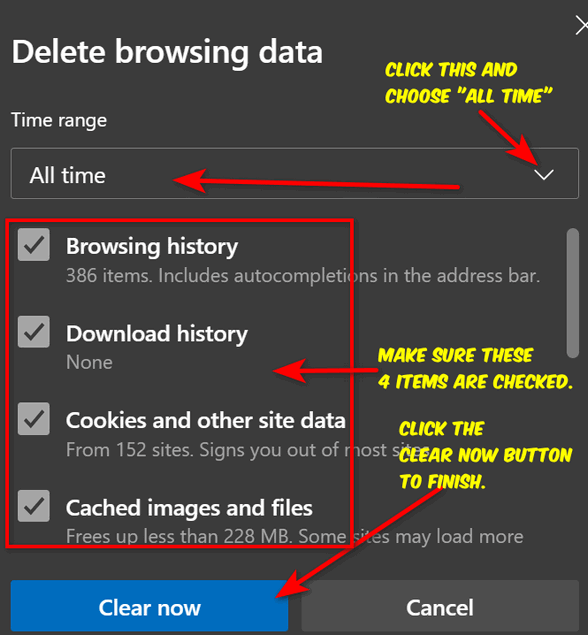
I have lost the list on the left of the screen (downloads docs, etc.). I used to have them on the taskbar - it is gone. Keep up the good work, you guys are doing to help all of us. Thanks. Susan.
Our answer
Hi Susan. Thanks so much. Try this... Hold down the Windows key and press the e key. It will open File Explorer. While File Explorer is open, look in your taskbar and you will see its icon ( it looks like a folder icon). Click on that icon and choose "Pin to taskbar". Now, when you click on that icon, you'll see a list of your folders, etc., on the left side of your screen.
------
Susan wrote back: "You fixed it. Thanks! Happy Halloween! Susan
Richard gets a serious hard drive error message
A few days ago, I got a notice on my computer, and I couldn't get past it. Will I have to get a new computer??? It is a Dell All-in-One, about 8 years old. Here is the message in the box.
"Boot Device not found---Please install an operating system on your hard drive---Hard Disk-(3F0)---F2-system diagnostics---For more information, please visit..."
Thank you for your help. Richard.
Our answer
Hi Richard. The error message "Hard Disk 3F0" indicates that your computer's BIOS or UEFI is unable to find a bootable device to load the operating system. This means that the computer cannot find the necessary system files to start up properly. It could mean the hard drive is bad, or it could mean there's a problem with the BIOS (UEFI), or it could mean the boot files are corrupted.
You can boot the computer using a Windows 10 or Windows 11 boot disk, but if the hard drive is bad, you may not be able to access your files or reinstall Windows.
The error message "Hard Disk 3F0" indicates that your computer's BIOS or UEFI is unable to find a bootable device to load the operating system. This means that the computer cannot find the necessary system files to start up properly.
It could mean the hard drive is bad, or it could mean there's a problem with the BIOS (UEFI), or it could mean the boot files are corrupted.
You can boot the computer using a Windows 10 or Windows 11 boot disk, but if the hard drive is bad, you may not be able to access your files or reinstall Windows.
If the hard drive is bad, you'll need to install a new drive or buy a new computer. Since your computer is 8 years old, you might be further ahead buying a new computer. While a new hard drive is not expensive, having someone put it in for you and then installing the operating system (in your case, Windows) can cost around $200 to $300 or more. So, it might be wiser just to put that money toward a new computer since your hardware is already 10 years old.
We can help save you money when choosing a new computer if it comes to that. We are sorry this happened to you, Richard. If you need any more help, just let us know.
![]()
We can fix your Windows computer... check out our low prices here!
![]()
Sandy asks about a laptop deal she saw on TV
One of the TV shopping channels recently advertised a 15.6-inch laptop with 128 GB SSD and 4 GB of RAM; I forgot the processor specs, with Windows 11 installed. They made the presentation look as if the laptop (Asus) was super fast and capable of many aspects of multitasking, as these people always tend to do, somehow. It was advertised as a holiday special for $199.95, with free shipping. I would be using it for only basic tasks such as web surfing, checking Email, and some streaming from Peacock, as well as YouTube video posts. Is this one laptop you would recommend, or should I avoid it like the plague? Thanks for all you do for us!
Our answer
Hi Sandy.
Thanks!
That computer will never be super-fast, as it does not have nearly enough RAM. Here's an ASUS computer from Amazon for about $100 more ($309) that has 16 GB of RAM, and it has a 512 GB SSD instead of the small 128 GB drive on the TV shopping site's computer. I would strongly advise you to spend an extra $100 and get a computer with plenty of RAM that won't bog down when you're multitasking, watching Peacock, or videos online.
![]()
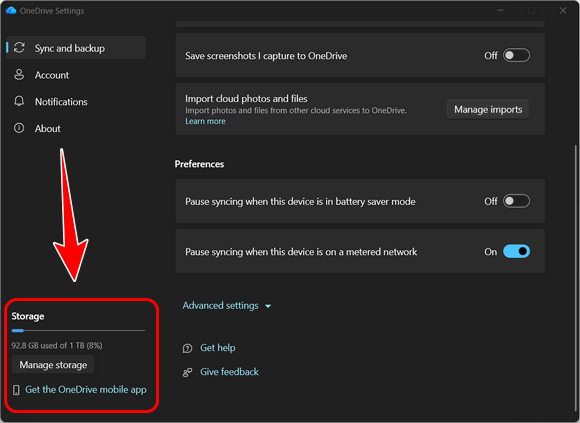
![]()
Hello. I've been a Cloudeight reader and supporter for lots of years. I hope you can help me with this. I have been trying to find your newsletter that showed how to put Windows 11 Safe Mode on the boot screen using a registry edit and the msconfig boot menu. Was that you guys, or do I have it all mixed up? Thanks, Michael.
Hi Michael. Thanks for your long-time friendship & support. There are several ways to boot into Safe Mode in Windows 11, depending on whether you can currently log into Windows or not. None of them requires editing the registry, which we very seldom ever recommend doing.
* Press 5 or F5 for Enable Safe Mode with Networking (if you need internet access).>> RECOMMENDED
* Press 6 or F6 for Enable Safe Mode with Command Prompt (for advanced users).

Now available: Reg Organizer 9.40
If you purchased or renewed Reg Organizer through Cloudeight within the
last 12 months, you're entitled to a free version upgrade to Reg
Organizer 9.31. Works great with Windows 10 and Windows 11.
Save $14 on Reg
Organizer right now!
Reg
Organizer - A Swiss Army Knife of Windows Tools - Works Great on Windows
10 and Windows 11.
![]()

Microsoft Plans On Turning Your Windows 11 PC into an AI-powered Super-Assistant
Windows 11
Microsoft’s determined that you’re going to love Copilot AI so much that you’re going to want to interact with it every day.
The following is our summary of a recent Microsoft Blog Post, which you can read here.
Microsoft just announced a massive update that basically turns every Windows 11 computer into a smart, proactive “AI PC.” They’re moving past the idea of Copilot as just a simple chatbot; now, it’s becoming a digital sidekick that can really do things for you.
The whole goal is simple: your computer should feel like it can understand you, see what you’re doing, and then act on your requests.
1. Talking and Seeing
Just Say “Hey Copilot”: Forget clicking or typing to start the AI. You can now just say “Hey Copilot” out loud, and it instantly wakes up, ready for your commands. It’s all about making talking to your PC as easy as talking to a person.
Copilot Can See Your Screen: This is a big one. With your permission, Copilot Vision can actually look at whatever is on your screen—whether it’s a tricky document, a PowerPoint presentation, or even a video game. It uses that context to give you super-relevant tips or help right when you need it.
Text Option for Vision: If you don’t want to talk, a new feature is coming that lets you type your question to the Vision feature, and the AI will type its answer back.
2. The AI Can Act for You (The “Agentic” Part)
Copilot Actions: This is where the magic happens. The AI isn’t just giving you instructions anymore; it’s an “agent” that can take over and perform multi-step tasks. For example, you could ask it to go into your files and automatically sort through a huge folder of photos to find and remove duplicates.
The “Manus” Website Builder: There’s a specialized AI agent called Manus coming to File Explorer. You could, for instance, right-click on a folder containing your resume and portfolio pictures and tell Manus to build a simple website for you instantly.
Smarter Search & Integration: Copilot is getting deep connections to things like your OneDrive files, Outlook emails, and even Google services (if you link them). This means you can ask it a complex question like, “Find the email with the flight confirmation from last week,” and it can actually dig through all those connected accounts to find the answer.
3. You’re Always in Control
Microsoft says they are making sure that while the AI is powerful, you’re the boss. All these features, especially the ones that interact with your local files and apps (like Copilot Actions), are turned off by default. You have to choose to enable them, and you can pause, stop, or disable them anytime. You’ll also be able to track exactly what the AI is doing, giving you full transparency.
In short, your Windows 11 PC is about to get a lot more hands-on, making it less of a passive tool and more of a helpful partner. If you’re a fan of AI, you’re probably going to love it. If you’re not a fan, hopefully you’ll have the option to remove Copilot and all its new features from your computer.
We’re just the messengers here. At least you know what’s coming.
How to Change Your Browser’s Default Search Engine
Windows 10/Windows 11 Users with Chrome, Edge, and/or Firefox browsers installed
In this tip, we’ll show you how to change the default search engine on the desktop (Windows) versions of the three most popular browsers, Google Chrome, Microsoft Edge, and Mozilla Firefox.
Surprisingly, for those of you who like DuckDuckGo, Chrome, Edge, and Firefox, it is easy for you to make DuckDuckGo the default search engine instead of Google or Bing. This is not a recommendation to use DuckDuckGo – we are just showing you that DuckDuckGo is an option in Chrome, Edge, and Firefox.
OK, ready? Here’s how to change your default search engine in the three most popular browsers.
Google Chrome
To change the default search engine in Google Chrome, follow these steps:
Open Google Chrome. Type or copy & paste
chrome://settings/search
In the address bar, and press Enter.
Scroll down to the “Search engine” section and click on the down arrow to the right of “Search engine to be used in the address bar”.
In the “Search engines” list, click on the search engine you would like to use as your default engine when you search from the Address bar. (See screenshot above).
Next, click on “Manage search engines and site search”
Under “Search engines,” click the 3 horizontal dots to the right of the search engine you want to use and click “Make default” (see screenshot below)
:
Close the “Settings” tab, and your new default search engine will be used from now on.
Note: If you don’t see the search engine you want to use in the list, you can add it by clicking on the “Add a new search engine” button and following the on-screen instructions.
Microsoft Edge
Type or copy & paste edge://settings/search in the address bar

Scroll down the page until you find “Search engine used in the address bar”. \
Next, click the little down arrow (see screenshot above) and choose whichever one you want. The default choices are Yahoo, Google, and DuckDuckGo.
You can add more search engines if you want, but those choices should be enough to get you started.
Mozilla Firefox
Type or copy & paste about:preferences#search in the Firefox address bar.
Under “Default Search Engine,” click the down arrow next to the current default search engine (see screenshot below)…

Select the search engine you want to set as your default from the menu that appears.
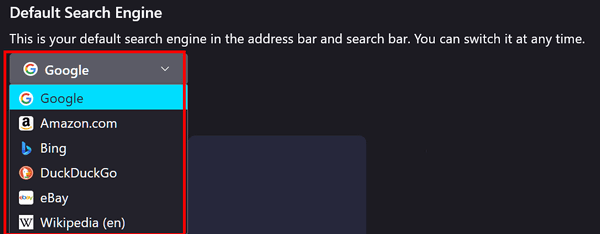
After you make your choice, the search engine you chose will be your default.
As with Chrome and Edge, Firefox allows you to add more search engines to the list of search engine choices.
And now you know how to change the default search engine in your favorite browser.
![]()
An Easy Multitasking Trick
Windows 10 / Windows 11
Did you know that in Windows 10 and 11, the Windows key + Tab key shortcut shows all your open programs on your desktop? That’s right! When you use the Windows key + Tab key shortcut, you can see all open programs on your desktop at once.
Let’s take a look…
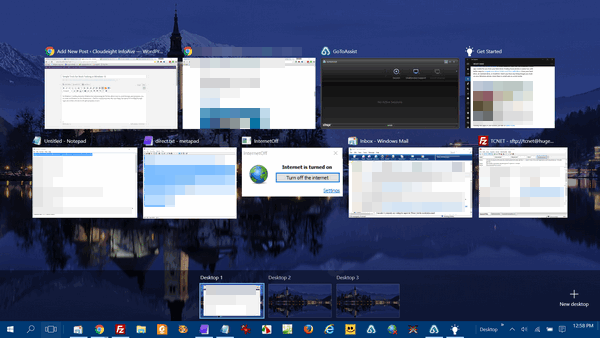
Above: Windows 10
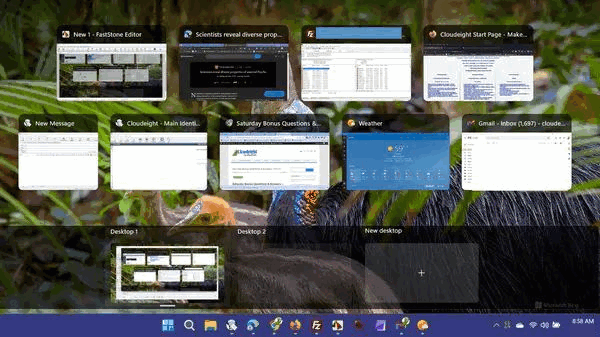
Above: Windows 11
If you’re using Windows 10 or 11 and want to see how many programs you have open, just press and hold the Windows Key and tap the Tab key. And you can click on any “thumbnail” and bring that program or app into focus. You can also close any of the programs by clicking on the “X” in the top-right corner of any of those open programs/apps without bringing them into focus… that’s correct, you can close any open program or app from its “thumbnail” on the desktop you see when you use the Windows key + Tab key shortcut.
Want more tips, tricks, and information?
We have thousands of Windows tips, tricks, and more on our InfoAve website.
Subscribe to our free InfoAve Daily newsletter.![]()

THANK YOU FOR HELPING US!
When you support us with a small gift, you help us continue our mission
to keep you informed, separate the truth from the hyperbole, and help
you stay safer online. Plus, our computer tips make your computer easier
to use.
Did you know that we provide support to thousands of people? Every week,
we help dozens of people via email at no charge. The questions and
answers you see in our newsletters are from the email answers and help
we provide to everyone free of charge.
Thanks to your gifts, we do a lot more than provide this free newsletter. We help you recognize online threats, fight for your online privacy, provide you with the knowledge you need to navigate the Web safely, provide you with suggestions for safe, free software and websites, and help you get more out of your PC.
Please help us keep up the good fight with a small gift.
Interested in making an automatic monthly gift? Visit this page. Help us keep helping you... and help us keep you safe on the Web
![]()

Search Your Computer Faster With Everything
Folks, we figured it's high time we brought back an oldie but a goodie. In the age of "everything AI", you can be almost sure that AI search engines for your PC are everywhere. My gut feeling is that when AI is everywhere, our security and privacy are nowhere to be found except in the empty promises of money-hungry AI captains trying to convince you that AI is the best thing to happen to he world since the Internet. Well, look how that's turning out!
As far as I know — or for as long as I can remember, at least — Windows has always had a search feature. It’s not always been particularly good. And it’s certainly not the fastest. In Windows XP and Vista, the Windows search feature was not very good and certainly not very fast. Windows 7 brought some improvements. Windows 10 and Windows 11 continued to improve the search feature. But Windows search is still not as fast as it should be, not as thorough as it could be, and not as fast as Everything Search – a free search program for Windows 10 and Windows 11.
Everything Search
Everything is not new; it’s been around for a long time. We’ve featured it before, but that was a couple of years ago. But seriously, it’s so good and so fast, it deserves mention.
Everything is made by Voidtools. The developer, David Carpenter, is so sure you’ll like Everything search, he is willing to put his name and his email address on the Everything website – and that says a lot about the program and the developer.
A few days ago, we decided to check it out again. ‘And once again, we found Everything Search to be exceptional. It is an amazingly fast and thorough search engine for Windows. It makes it easy to find whatever you’re looking for on your computer.
I did a couple of quick tests. And Everything produced great search results instantly. We looked for all files on my laptop with the “white.mid” in their names in the first test. Everything found, well, everything with “white.mid” in its name in the blink of an eye.
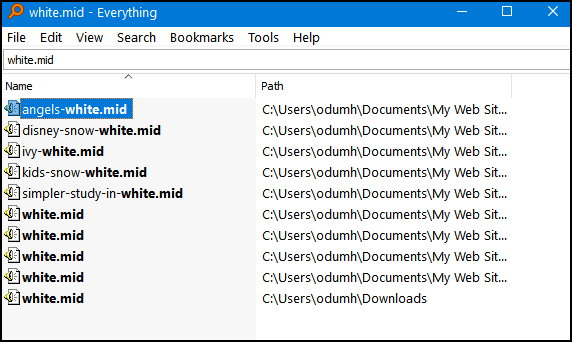
Let’s see if Everything can find “Ice Castles”, one of my favorite midis from our stationery days. You can even change the view from Details to Icon views and more.
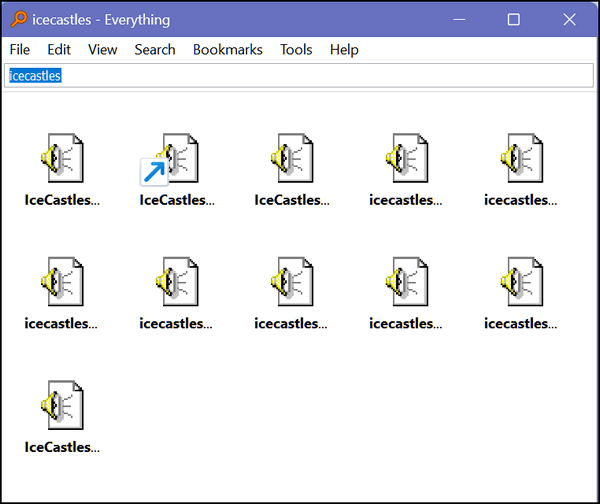
And in another test, I just looked for all PDF files on my laptop. I have PDF files on this old laptop going back to 2013. I have saved quite a few in the last eight years. To find them all, I used the wildcard * (that is, *.PDF) to search for all PDF files. In less than 2 seconds, it found every PDF file on my laptop – and there are a whole lot of them. The search results can be ordered by name, date, type, etc. Below you can see Everything showing all PDF files on my laptop (some going all the way back to 2013) by name.
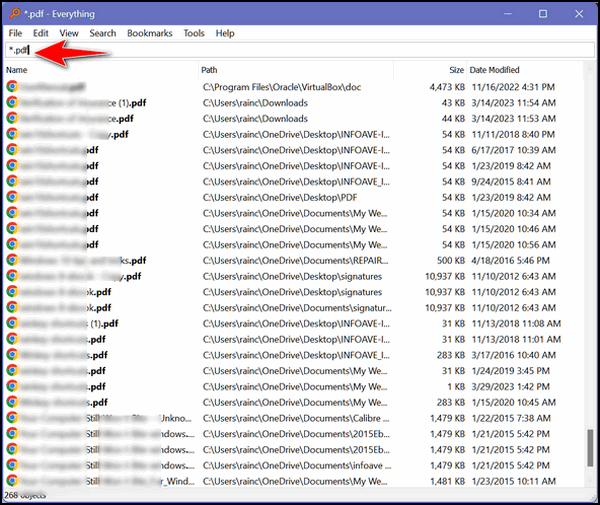
So, with our tests completed successfully, it’s time to bring in David Carpenter, the developer of Everything, to answer your questions:
What is “Everything”?
“Everything” is a search engine that locates files and folders by filename instantly for Windows.
Unlike Windows search, “Everything” initially displays every file and folder on your computer (hence the name “Everything”).
You type in a search filter to limit what files and folders are displayed.
How long will it take to index my files?
“Everything” only indexes file and folder names and generally takes a few seconds to build its database.
A fresh install of Windows 11 (about 120,000 files) will take about 1 second to index.
1,000,000 files will take about 1 minute.
Does Everything search file contents?
Yes, “Everything” can search file content with the content search function.
File content is not indexed, searching content is slow.
Does “Everything” hog my system resources?
No, “Everything” uses very little system resources.
A fresh install of Windows 10 (about 120,000 files) will use about 14 MB of RAM and less than 9 MB of disk space.
1,000,000 files will use about 75 MB of RAM and 45 MB of disk space.
Does “Everything” monitor file system changes?
Yes, “Everything” does monitor file system changes.
Your search windows will reflect changes made to the file system.
Is “Everything” free?
Yes, “Everything” is Freeware.
Please consider donating.
Does “Everything” contain any malware, spyware or adware?
No, “Everything” does not contain any malware, spyware or adware…
If you want to read more about Everything, visit this page.
Everything is available for download as a portable app or with an installer. It’s available in 32-bit and 64-bit versions. If you’re looking for a faster, better way to find files on your Windows PC, give “Everything” a try. It’s fast, free, and it’s not bundled with anything else, and it contains no malware or badware. And you’ll be happy to know the author does not play whack-a-mole with the download links.
You can download Everything from this page.
You’ll have several installation options to choose from. If you’re an advanced user, you can modify these however you wish. If you’re not an advanced user or you are a minimalist like us, just install Everything as it comes. It works great right out of the box, as they say.
![]()

Lucy Jupiter and the Forest of Secrets (Part II)
If you missed Part I, you can read it here.
Introduction
Last week, we introduced Lucy Jupiter and the Forest of Secrets. Lucy Jupiter is a quiet girl who blends into the background at school but holds a powerful secret: she can command the forest. Her only true confidant is her shaggy dog, Millie, who, unknown to everyone, can communicate with her. Together, they are the trusted protectors of the Miglets, tiny, leaf-draped beings who live hidden among the ancient tree roots. This peaceful, magical world is shattered when an urgent warning arrives from a Miglet elder named Thimble: the terrifying, exiled spirit Puglim has returned, bringing with him the destructive, poison-clawed invaders known as the Rotham.
Driven by a desperate call for help, Lucy and Millie race to save trapped Miglet families at Willow Vale. Lucy uses her unique power to bind the Rotham with roots and vines while Millie bravely creates a distraction, allowing the innocents to escape. Their victory is short-lived, however, as Puglim appears, forcing a revelation: Millie dramatically transforms from a simple mutt into a powerful, silver-furred Guardian—sent long ago to protect Lucy, who she insists is “more than she realizes.” The true danger deepens as they discover a betrayal within their own ranks, revealing that the jealous Miglet Spook has been secretly dealing with Puglim, exposing their strengths in a quest for dark power and setting the stage for a final, intense conflict.
Let’s continue now with Part II of the story of…
Lucy Jupiter and the Forest of Secrets: Part II
Chapter 7: The Final Stand
Puglim gathered his forces. The Rotham multiplied. The forest darkened.
Lucy knew it was time.
She stood at the heart of the forest, Millie beside her, the Miglets behind her.
Puglim arrived, towering and furious.
“You cannot win,” he roared.
Read more of the continuing story of Lucy Jupiter here.

What does "Agentic" mean?
When discussing AI, browsers, or other software, the term "agentic" means: The ability of an AI system to take initiative and act on your behalf to achieve a complex, multi-step goal, often making its own decisions along the way.
Think of it this way: Non-Agentic (Simple Tool):
You tell it exactly what to do, step-by-step. (Example: "Search for 'pizza near me with prices'. It executes that one command.
Agentic (Smart Assistant):
You give it a high-level objective, and it figures out the best way to accomplish it, breaking it down into smaller steps. (Example: "Plan a weekend trip to Chicago, find the best flight/hotel deals, and suggest three sightseeing options and show prices. The AI agent will automatically search for flights, compare hotel prices, check dates, and then present a complete itinerary. An agentic AI doesn't just respond to a command; it has a degree of autonomy, memory (to keep track of its progress), and reasoning (to adjust its plan if a step fails). It’s an intelligent, goal-driven tool that works independently to deliver a finished result.
In human terms, I think things may be getting carried away, as too many people these days already don't do enough thinking for themselves; they seem to love to let others think for them. It's bad enough when people let other people the thinking for them, but entrusting our lives, our wants, our desires, our dreams, our needs, and our hopes to "agentic" AI tools seems a bit foolhardy to me. You know what they say... "Fools rush in." But, no one is going to be able to stop it no matter how hard they try. Why? $$$. There are trillions of dollars to be made and humanity aside, someone is going to make it and take it..
![]()

Sales of the following products and services help support our newsletters, websites, and free computer help services we provide.
Cloudeight Direct Computer Care:
Single Keys, SeniorPass, or Season Tickets - always a great deal. Cloudeight Direct Computer Care is like having PC insurance.
Get more information here.
Emsisoft Anti-Malware: Emsisoft is the only Cloudeight-endorsed and recommended Windows security program. It provides users with a complete antivirus, antimalware, anti-ransomware,
and anti-PUPs solution. We offer single Emsisoft licenses and multi-computer licenses at discount prices. Also, we offer our exclusive Emsisoft with Cloudeight installation & setup.
Get more information here.
Reg Organizer: Reg Organizer is the Swiss Army Knife of Windows tools. It's far more than just a registry optimizer and cleaner... it's a Windows all-in-one toolkit. Reg Organizer helps you keep your computer in tip-top shape and helps you solve annoying Windows problems. Reg Organizer works great with Windows 10
and Windows 11! Get more information about Reg Organizer (and get our special discount prices) here.
MORE IMPORTANT STUFF!
Your InfoAve Weekly Members' Home Page is located here.
Help us grow! Forward this email newsletter to a friend or family member - and have them sign up for InfoAve Weekly here!
Get our free daily newsletter! Each evening, we send a short newsletter with a tip or trick or a computer-related article - it's short and sweet - and free. Sign up right now.
We have thousands of Windows tips and tricks and computer articles posted on our Cloudeight InfoAve website. Our site has a great search engine to help you find what you're looking for, too! Please visit us today!
Help us by using our Start Page. It costs nothing, and it helps us a lot.
Print our Cloudeight Direct Flyer and spread the word about our computer repair service! If you want to help us by telling your friends about our Cloudeight Direct Computer Care service, you can download a printable flyer that you can hand out or post on bulletin boards, etc. Get the printable PDF Cloudeight Direct Computer Care flyer here.

We'd love to hear from you!
If you have comments, questions, a tip, a trick, a freeware pick, or just want to tell us off for something, let us know.
If you need to change your newsletter subscription address, please see "Manage your subscription" at the very bottom of your newsletter.
We received hundreds of questions for possible use in IA news. Please keep in mind that we cannot publish all questions and answers in our newsletters, but we try to answer every single question. We can only use a few in each week's newsletter. If you have a support question about a service or product we sell, please contact us here.
Subscribe to our Daily Newsletter! Get computer tips & tricks every night. Our daily newsletter features a computer tip/trick or two every day. We send it out every night around 9 PM Eastern Time (USA). It's short and sweet, easy to read, and FREE. Subscribe to our Cloudeight InfoAve Daily Newsletter!

We hope you have enjoyed this issue of Cloudeight InfoAve Weekly. Thanks so much for your support and for being an InfoAve Weekly subscriber.
Have a great weekend. Be safe!
Darcy & TC
Cloudeight InfoAve Weekly - Issue #1150
Volume 23, Number 1
October 24, 2025
Not a subscriber? Subscribe to our FREE Cloudeight InfoAve Weekly Newsletter here.

"Cloudeight InfoAve Weekly" newsletter is published by:
Cloudeight Internet LLC
PO Box 73
Middleville, Michigan, USA 49333-0073
Read our disclaimer about the tips, tricks, answers, site picks, and freeware picks featured in this newsletter.
Copyright ©2025 by Cloudeight Internet
